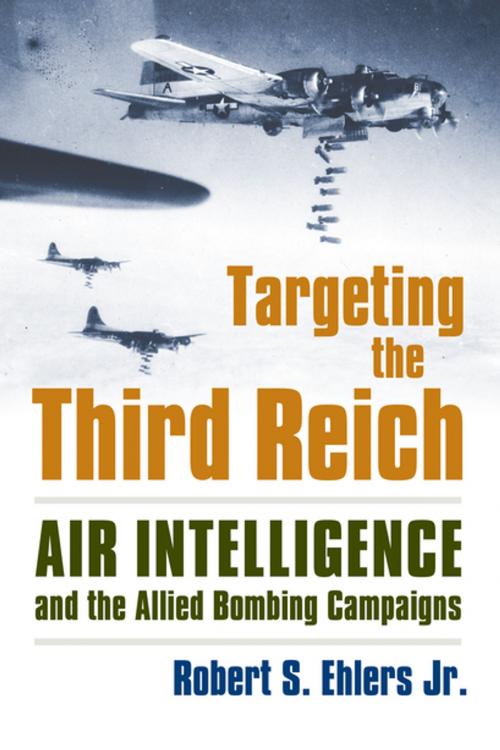Targeting the Third Reich
Air Intelligence and the Allied Bombing Campaigns
Nonfiction, History, Military, World War II| Author: | Rober S. Ehlers Jr. | ISBN: | 9780700621811 |
| Publisher: | University Press of Kansas | Publication: | July 15, 2015 |
| Imprint: | University Press of Kansas | Language: | English |
| Author: | Rober S. Ehlers Jr. |
| ISBN: | 9780700621811 |
| Publisher: | University Press of Kansas |
| Publication: | July 15, 2015 |
| Imprint: | University Press of Kansas |
| Language: | English |
When large formations of Allied four-engine bombers finally flew over Europe, it marked the beginning of the end for the Third Reich. Their relentless hammering of Germany--totaling more than 1.4 million missions--took out oil refineries, industries, and transportation infrastructures vital to the Reich's war effort. While other accounts have focused on operational details, this is the first book to reveal the crucial role of air intelligence in these dramatic campaigns.
Robert Ehlers reexamines these bombings through the lens of both air intelligence and operations, a dual approach that shows how the former was so vital to the latter's success. Air intelligence was essential to both targeting and damage assessment, and by demonstrating its contributions to the Combined Bomber Offensive of 1943-1945, Ehlers provides a wealth of new insight into the war.
Ehlers describes the close ties that developed between the Royal Air Force's "precision intelligence" arm and the U.S. Army Air Force's "precision bombardment" forces, telling how the RAF's photographic reconnaissance and signals intelligence steered both British and American bombers to the right targets at the right intervals with the right munitions. He shows that the greatest strength of this partnership was its ability to orchestrate all aspects of damage assessment within an effective organizational structure, so that by 1944 senior air commanders--like the RAF's Arthur "Bomber" Harris and the AAF's Carl "Tooey" Spaatz--could gauge the accuracy of bombing with a high degree of precision, analyze its effects on the German war effort, and determine its effectiveness in helping the Allies achieve strategic objectives.
Ehlers focuses on three key offensives in 1944--against French and Belgian rail supply lines delivering German troops and supplies to Normandy, against German oil refineries, and against railroads and waterways inside the Reich--that had a disastrous effect on the Nazi war effort. In the process, he underscores the degree to which bombers constituted part of a highly effective combined-arms force, giving Allied armies crucial advantages on the battlefield. Drawing on a huge collection of bomb-damage assessment photographs and a wealth of other archival sources, he shows that the success of these and other efforts can be traced directly to the success of air intelligence.
Providing a deeper and more accurate understanding of the bomber campaigns' role in the Allied victory, Ehlers's study testifies to the strategic importance of these efforts in that war and provides a tool for understanding the importance of intelligence operations in future conflicts.
When large formations of Allied four-engine bombers finally flew over Europe, it marked the beginning of the end for the Third Reich. Their relentless hammering of Germany--totaling more than 1.4 million missions--took out oil refineries, industries, and transportation infrastructures vital to the Reich's war effort. While other accounts have focused on operational details, this is the first book to reveal the crucial role of air intelligence in these dramatic campaigns.
Robert Ehlers reexamines these bombings through the lens of both air intelligence and operations, a dual approach that shows how the former was so vital to the latter's success. Air intelligence was essential to both targeting and damage assessment, and by demonstrating its contributions to the Combined Bomber Offensive of 1943-1945, Ehlers provides a wealth of new insight into the war.
Ehlers describes the close ties that developed between the Royal Air Force's "precision intelligence" arm and the U.S. Army Air Force's "precision bombardment" forces, telling how the RAF's photographic reconnaissance and signals intelligence steered both British and American bombers to the right targets at the right intervals with the right munitions. He shows that the greatest strength of this partnership was its ability to orchestrate all aspects of damage assessment within an effective organizational structure, so that by 1944 senior air commanders--like the RAF's Arthur "Bomber" Harris and the AAF's Carl "Tooey" Spaatz--could gauge the accuracy of bombing with a high degree of precision, analyze its effects on the German war effort, and determine its effectiveness in helping the Allies achieve strategic objectives.
Ehlers focuses on three key offensives in 1944--against French and Belgian rail supply lines delivering German troops and supplies to Normandy, against German oil refineries, and against railroads and waterways inside the Reich--that had a disastrous effect on the Nazi war effort. In the process, he underscores the degree to which bombers constituted part of a highly effective combined-arms force, giving Allied armies crucial advantages on the battlefield. Drawing on a huge collection of bomb-damage assessment photographs and a wealth of other archival sources, he shows that the success of these and other efforts can be traced directly to the success of air intelligence.
Providing a deeper and more accurate understanding of the bomber campaigns' role in the Allied victory, Ehlers's study testifies to the strategic importance of these efforts in that war and provides a tool for understanding the importance of intelligence operations in future conflicts.















